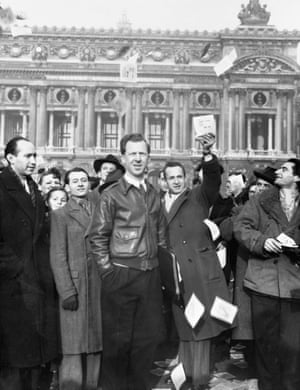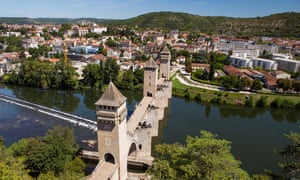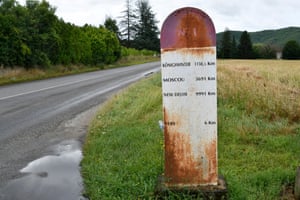Mondialists, unite! The forgotten story of a global pacifist movement | Cities
In 1948, a dashing American actor and wartime hero surrendered his passport at the US embassy in Paris. He would go on to live the rest of his 92 years without any ID besides a passport he had printed himself, declaring him to be a “citizen of the worldâ€. It had no other function than a symbolic one. Unsurprisingly, he was often arrested at borders.
His name was Garry Davis, a former Broadway actor and dancer, turned bomber pilot, turned pacifist. The depredations of two world wars â€" one that he witnessed close up â€" had convinced Davis that nation states were obsolete at best, and dangerous at worst. Only a global citizenship, he believed, could save people from their nationalist impulses.
The movement still resonates today. The passports are still being printed in Washington DC by Davis’s old friend and lawyer, David Gallup. Barack Obama owns one. So does Edward Snowden. Some 200,000 people are currently listed as “citizens of the world†on the association’s register in Paris, where its headquarters remain.
But almost forgotten is another project in the postwar effort to eliminate warfare for good â€" a project that initially seemed even more promising.
The seeds of this idea were sown when Robert Sarrazac, an officer in the French army, saw a photograph of Davis on the front page of the France Soir newspaper. The picture was taken as Davis was busy interrupting the third UN general assembly â€" then held in Paris’s Chaillot Palace. Sarrazac wrote to Davis, and they agreed to meet.

Sarrazac (whose real name was Robert Soulage) was a Catholic who had joined the French Resistance in 1942 and become a propagandist for the French ministry of prisoners at the end of the war. He, too, was fired up by a big global idea; but rather than world citizens, he wanted to create a network of world cities, freed from the shackles of their countries.
The two men became collaborators. Sarrazac and Davis believed the 400-year-old concept of the nation state was obsolete, an institution whose only function was to drag people into unwanted wars. “To insure the survival of humanity,†they wrote, their ambition was to create a “mondialist†(globalist) zone where the first elections for a new people’s assembly would be held.
The first official global city, they announced, wouldn’t be London, New York or even Paris. It would be Cahors, a tiny city in the Lot, a rural department in sunny south-western France that is now better known for its grottoes, castles and gastronomy than for a unique experiment in globalist utopia.
If the location seemed out of the way, the timing was certainly ripe. The postwar period had been anything but peaceful: Churchill was talking about an iron curtain as early as 1946, civil war was raging in Greece, and Moscow was on bad terms with Tito (Yugoslavia’s then president). The year in which Davis met Sarrazac opened with Gandhi’s assassination and closed with the Prague coup. The next year, 1949, the Soviet Union acquired the nuclear bomb, and 1950 saw the outbreak of conflict in Korea. It was only natural to see a third world war on the horizon.
At the same time, the supporters of a unified world were growing more numerous by the day, led by prestigious ambassadors such as Albert Einstein. “There was a competition for who was best defending peace,†says Stéphane Dufoix, a French sociologist and expert on the mondialist movement. “You had the communist peace on one side, and the free world’s on the other. It was hard for the mondialists to make room for themselves in the middle.â€
Nevertheless, they tried. To make themselves heard they coined new terms: “mondialisation†and “mondiality†aimed to reflect the growing feeling that societies and economies were, increasingly, intertwined.
Cahors, the global city
It was a chance encounter on a train between Toulouse and Paris in February 1949 that pointed Sarrazac towards Cahors. On the train he met Emile Baynac, a teacher from the city, and the two men discovered they shared acquaintances in resistance circles.
Baynac returned to Cahors with Sarrazac’s ideas fresh in his head, and spread them to other “Cadurciensâ€, as residents are known, including Dr Louis Sauvé, a humanist who became the local leader of the movement and is still alive today at 99.
That June, Sarrazac and Davis embarked on a tour of south-western France. Over 11 days they held 12 open-air meetings, and in Cahors, along with Sauvé, they wrote the Charter of Mondialisation at café Le Bordeaux opposite the town hall.

“Our security and our wellbeing is linked to the security and the wellbeing of all the cities in the world, currently under the threat of being destroyed by total war,†reads the first article of the charter. “We want to work in peace. To organise a general assembly of the world’s people and to directly elect our representatives.†It went on to call for the establishment of Cahors as a global city, with a provision that a percentage of the Lot department’s military budget would be allotted to prepare global elections.
The expression “general assembly†(etats généraux) is no coincidence. Sarrazac was searching for his very own Vizille â€" the small town near Grenoble whose etats généraux in 1788 sparked what would become the French revolution. To his mind, a movement needed a headquarters and Cahors â€" the home of illustrious men such as Pope John XXII and statesman Léon Gambetta â€" was the perfect bedrock. “To him, this experimentation was only the beginning of something formidable that would change the world,†says Michel Auvray, a Cahors-based historian currently writing a book on the movement.
But the Charter needed to be adopted to have any effect, so on his return to Paris, Sarrazac gave instructions to the new mondialist “troops†in the south to win hearts “farm by farmâ€. “He knew that, down the line, the vote at the general council â€" the institution in charge of the Lot department â€" would matter the most,†says Auvray.
The “pilot electionsâ€, as they were called, took place in July in Cahors’ local shops. The mood in the city was festive: the town hall fluttered with the flags of other countries, and the windows along Boulevard Gambetta were covered with the rainbow colours of the mondialist pennant.
When the votes were tallied, 59% had agreed to adopt the charter. On a motion in September, the general council voted in favour as well, and the city officially changed its name from Cahors to Cahors-Mundi, while encouraging the other communes of the department to follow its lead.

From mondialisation to globalisation
Today, Cahors is a peaceful city of 12,000, famous for its wine â€" Malbecs known as “black wine†because of their extreme opaqueness â€" and a 14th-century fortified bridge. It is hard to image this medieval French town beloved by Japanese tour operators as a hotbed of utopian fervour.
But several factors explain why the global cities idea took off so swiftly here. For one thing, the region had a history of rebelliousness. “There’s a tradition of wariness towards central power in the Lot,†Auvray says. “For example, during the revolution, and then the empire, it was one of the regions in France with the highest number of draft dodgers.â€
Secondly, the movement was backed by local officials. It helped that, unlike the communists, mondialists didn’t criticise the war in Indochina or the French government’s alignment with Washington.
Famous intellectuals also joined in. Several members of the surrealist movement signed the charter, and in late June of 1950 the “road without borders no 1†was inaugurated in Cahors in the presence of Lord Boyd Orr (the first director-general of the UN’s Food and Agriculture Organisation and winner of the Nobel Peace Prize in 1949), and the renowned French writer André Breton, as well as several thousand Cadurciens. The occasion sparked one of the first fireworks displays in Cahors since VE Day.
The sparks caught: by the end of 1950, more than 300 communes in the Lot had signed the charter.

The activists, however, were tired and in debt. The Korean war began the same day the road was inaugurated â€" but rather than energise the utopians, it seemed to demoralise them. Although towns in the nearby department of Gard took up the charter, they did it in a more token, less panache-filled spirit. A falling out between Davis and Sarrazac made matters worse.
When the Algerian war broke out in 1954, no dissident voices emerged from the Lot. Faced with its first real test, the global cities movement stopped moving. It was an idea that “emerged fast and strong and went down just as quicklyâ€, says Cahors mayor Jean-Marc Vayssouze-Faure.
‘The time the American came to town’
In the years since, “globalisation†has become the defining buzzword of international politics â€" though it has taken on quite a different meaning from the one intended by Sarrazac and David. In 2000, to mark the 50th anniversary of the Cahors events, the two estranged collaborators reunited in the city for a celebration, during which Sauvé declared: “These terms that we crafted convey the exact opposite of what we were trying to do at the time.â€
Today, most people in Cahors remember the signing of the charter as “the time the American came to townâ€, if they remember it at all. The few remaining milestones on what was once the “road without borders†barely get a passing look.
“This idea is a true gem, it’s like sleeping gold,†says Pierre Petric, the Serbian founder of the association Cahors-Mundi. “I am shocked that people in Cahors are not more interested in those events.†Petric says he would like to see the mondialist movement classified as “intangible heritage†of the city of Cahors.
“Often, we’re reminded of this story through foreigners,†says Bernard Delpech, a history teacher in the town who calls himself the only mondialist on the municipal council. “It tells us the tale of a globalisation, which started through cultural ties.â€
Indeed, it is outside France where the idea still has the most life. Several towns around the world continue to declare themselves “mondialised†(in Togo, in Senegal and most recently in the DRC) as a way to defy the possibility of war, or to put themselves on the map of cooperation and solidarity. Both Delpech and the mayor of Cahors â€" who keeps a black-and-white portrait of Sauvé in his office â€" have plans to launch a project of cooperation with other mondialised cities, perhaps in 2019 on Cahors-Mundi’s 70th birthday.
The symbol of the global city remains an effective one. As the idea of globalisation falters and tensions between nations ratchet up once more, is the world ready to revisit the older idea of global cities?
“The quotes of the Cahors movement could be printed verbatim in the newspapers today, and they would be audible and significant,†says the sociologist Dufoix. “That simply wouldn’t have been the case 25 years ago.â€
He points to a note written in 1949 by the director of the Lot’s teacher academy to its pupils, which reads:
You may ask yourselves what a mondialised department means … First of all, it means that the inhabitants of the Lot, while staying French citizens of course, recognise that they also belong to a larger community: the world community, and that they have in common with other men and peoples in the world certain needs and preoccupations such as eating, wearing clothes, finding shelter and most importantly, living and working in peace … Why wouldn’t men sit together and work together to solve these issues?â€
Follow Guardian Cities on Twitter and Facebook to join the discussion, and explore our archive here

0 Response to "Mondialists, unite! The forgotten story of a global pacifist movement | Cities"
Posting Komentar